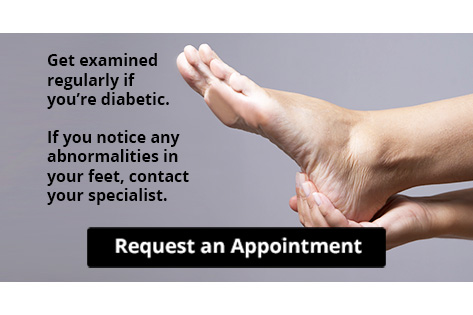Items filtered by date: February 2025
The Stages of Ingrown Toenails
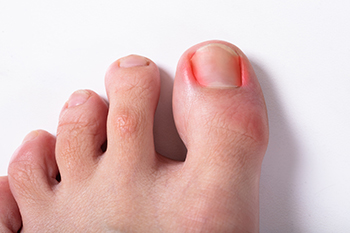
Ingrown toenails occur when the edges of the toenail grow into the surrounding skin, causing pain, swelling, and redness. The condition typically affects the big toe and can be caused by improper nail trimming, wearing tight shoes, or injury. There are three stages of ingrown toenails. Stage 1 is when the skin around the nail becomes red and tender. You may notice slight swelling, and it can feel sore when touched. Stage 2 is when the pain intensifies, and the area may become more swollen. Pus or drainage can develop, signaling possible infection. Stage 3 is when the infection worsens and the skin surrounding the toenail may become thickened, with an increased risk of chronic pain or permanent damage. A podiatrist can determine what stage your ingrown toenail is in and design a treatment plan. They can help by expertly trimming the nail or gently lifting the nail, removing any infected tissue, and offering advice to prevent future ingrown nails. If you are experiencing an ingrown toenail, it is suggested that you schedule an appointment with a podiatrist to get the proper care and avoid complications.
Ingrown toenails may initially present themselves as a minor discomfort, but they may progress into an infection in the skin without proper treatment. For more information about ingrown toenails, contact one of our podiatrists of Highlands Foot and Ankle. Our doctor can provide the care you need to keep you pain-free and on your feet.
Ingrown Toenails
Ingrown toenails are caused when the corner or side of a toenail grows into the soft flesh surrounding it. They often result in redness, swelling, pain, and in some cases, infection. This condition typically affects the big toe and may recur if it is not treated properly.
Causes
- Improper toenail trimming
- Genetics
- Improper shoe fitting
- Injury from pedicures or nail picking
- Abnormal gait
- Poor hygiene
You are more likely to develop an ingrown toenail if you are obese, have diabetes, arthritis, or have any fungal infection in your nails. Additionally, people who have foot or toe deformities are at a higher risk of developing an ingrown toenail.
Symptoms
Some symptoms of ingrown toenails are redness, swelling, and pain. In rare cases, there may be a yellowish drainage coming from the nail.
Treatment
Ignoring an ingrown toenail can have serious complications. Infections of the nail border can progress to a deeper soft-tissue infection, which can then turn into a bone infection. You should always speak with your podiatrist if you suspect you have an ingrown toenail, especially if you have diabetes or poor circulation.
If you have any questions, please feel free to contact our office located in Waco, TX . We offer the newest diagnostic and treatment technologies for all your foot care needs.
Custom Orthotics Seasonal - Any Season

Rain or shine, snow or sleet, Custom Orthotics have your feet covered! As the seasons change, ensure your steps remain comfortable and supported. Custom Orthotics adapt to your footwear, from summer sandals to winter boots, providing consistent relief and alignment. Don't let the changing weather dictate your foot comfort. Step confidently year-round and experience the difference with Custom Orthotics. Call today for more information.
A Simple Guide for Foot Wound Care
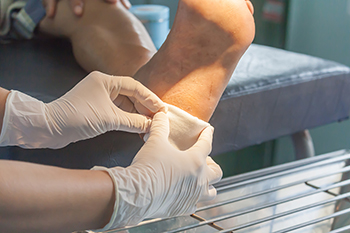
Foot wounds can lead to serious complications if not cared for properly. A podiatrist is a trained specialist who takes specific steps to clean and treat a foot wound to ensure it heals effectively and reduces the risk of infection. After the hands are washed, the wound is assessed for any foreign debris, such as dirt or stones. Using sterile gauze or a clean cloth, the wound is cleaned with mild soap and water, and caution is taken to not scrub the affected area. This is followed by applying a suitable antiseptic solution to disinfect the wound. Once the area is properly cleaned and disinfected, the wound is covered with a sterile bandage to create a protective barrier, promoting faster healing. If you have sustained a foot wound, it is suggested to seek professional care from a podiatrist to ensure the wound is treated appropriately and to receive guidance on the best care practices for your specific injury.
Wound care is an important part in dealing with diabetes. If you have diabetes and a foot wound or would like more information about wound care for diabetics, consult with one of our podiatrists from Highlands Foot and Ankle. Our doctor will assess your condition and provide you with quality foot and ankle treatment.
What Is Wound Care?
Wound care is the practice of taking proper care of a wound. This can range from the smallest to the largest of wounds. While everyone can benefit from proper wound care, it is much more important for diabetics. Diabetics often suffer from poor blood circulation which causes wounds to heal much slower than they would in a non-diabetic.
What Is the Importance of Wound Care?
While it may not seem apparent with small ulcers on the foot, for diabetics, any size ulcer can become infected. Diabetics often also suffer from neuropathy, or nerve loss. This means they might not even feel when they have an ulcer on their foot. If the wound becomes severely infected, amputation may be necessary. Therefore, it is of the upmost importance to properly care for any and all foot wounds.
How to Care for Wounds
The best way to care for foot wounds is to prevent them. For diabetics, this means daily inspections of the feet for any signs of abnormalities or ulcers. It is also recommended to see a podiatrist several times a year for a foot inspection. If you do have an ulcer, run the wound under water to clear dirt from the wound; then apply antibiotic ointment to the wound and cover with a bandage. Bandages should be changed daily and keeping pressure off the wound is smart. It is advised to see a podiatrist, who can keep an eye on it.
If you have any questions, please feel free to contact our office located in Waco, TX . We offer the newest diagnostic and treatment technologies for all your foot care needs.
Inspect Your Feet Regularly for Abnormalities if You're Diabetic
Walking Better With Orthotics
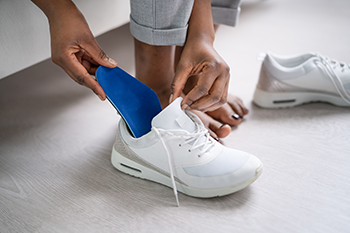
Custom orthotics can significantly alleviate walking discomfort by addressing the root causes of pain and improving foot mechanics. They are tailored to the unique shape and needs of an individual’s feet, offering support where it is needed most. For those with flat feet, orthotics provide arch support to prevent overpronation, reducing strain on the feet, ankles, and knees. In cases of high arches, they offer cushioning to absorb shock and evenly distribute pressure across the foot. By correcting alignment and improving gait, orthotics reduce discomfort caused by conditions like plantar fasciitis, arthritis, or bunions. They also enhance balance and stability, making walking more efficient and less tiring. Whether you walk for exercise or daily activities, custom orthotics provide personalized comfort and support, helping you move with ease and confidence while preventing further issues. If you have foot pain while walking, it is suggested that you consult a podiatrist for an evaluation and treatment, which might include prescribing custom orthotics.
If you are experiencing discomfort in your feet and would like to try custom orthotics, contact one of our podiatrists from Highlands Foot and Ankle. Our doctor can provide the care you need to keep you pain-free and on your feet.
What Are Custom Orthotics?
Custom orthotics are inserts you can place into your shoes to help with a variety of foot problems such as flat feet or foot pain. Orthotics provide relief and comfort for minor foot and heel pain.
Over-the-Counter Inserts
Shoe inserts come in a wide variety and are used to treat foot pain, heel pain, and minor problems. For example, arch supports can be inserted into your shoes to help correct overarched or flat feet, while gel insoles are often used because they provide comfort and relief from foot and heel pain by alleviating pressure.
Prescription Orthotics
If over-the-counter inserts don’t work for you or if you have a more severe foot concern, it is possible to have your podiatrist prescribe custom orthotics. These high-quality, custom inserts are designed to treat problems such as abnormal motion, plantar fasciitis, and severe forms of heel pain. They can even be used to help patients suffering from diabetes by treating foot ulcers and painful calluses and are usually molded to your feet individually, which allows them to provide full support and comfort.
If you're experiencing minor to severe foot or heel pain, it’s recommended to speak with your podiatrist about the possibility of using custom orthotics or shoe inserts. A podiatrist can determine which type of custom orthotic or shoe insert is right for you and help you take the first steps toward being pain-free.
If you have any questions please contact our office located in Waco, TX . We offer the newest diagnostic and treatment technologies for all your foot and ankle needs.
Preventing Toenail Issues While Running
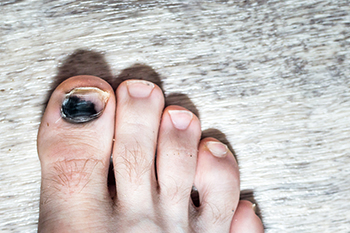
Running can put significant stress on the feet, often leading to various toenail issues. Common toenail conditions caused from running include black toenails, ingrown toenails and fungal infections, in addition to thickened nails, and toenail trauma. Black toenails usually occur from repeated impact, causing blood to pool under the nail. Ingrown toenails develop when the edges of the toenail grow into the surrounding skin, often causing pain and infection. Fungal infections thrive in a warm, moist environment created by sweat, leading to discoloration and thickened nails. Toenail trauma can happen from wearing ill-fitting shoes or improper running form. Preventing these issues requires wearing properly fitting shoes with enough room for the toes to move freely. Regularly trimming toenails straight across can help avoid ingrown nails, while keeping feet dry and using antifungal treatments can reduce the risk of infections. Additionally, performing proper nail care and recovery time after long runs can help prevent toenail damage. If you have developed toe pain from running, it is suggested that you consult a podiatrist who can provide an accurate diagnosis and treatment.
Exercising your feet regularly with the proper foot wear is a great way to prevent injuries. If you have any concerns about your feet, contact one of our podiatrists of Highlands Foot and Ankle. Our doctor will treat your foot and ankle needs.
How to Prevent Running Injuries
Many common running injuries are caused by overuse and overtraining. When the back of the kneecap starts wearing out and starts causing pain in your knee, this is commonly referred to as runner’s knee. Runner’s knee is a decrease in strength in your quadriceps and can occur if you’re not wearing properly fitted or supporting shoes. To prevent runner’s knee, focusing on hip strengthening is a good idea, as well as strengthening your quads to keep the kneecaps aligned.
What Are Some Causes of Running Injuries?
- One cause of a common running injury is called iliotibial band syndrome.
- Plantar fasciitis is also another common injury.
- Stress fractures can occur from overtraining, lack of calcium, or even your running style.
Best Ways to Prevent Running Injuries
- Wear footwear that fits properly and suits your running needs.
- Running shoes are the only protective gear that runners have to safeguard them from injury.
- Make a training schedule. Adding strengthening exercises as well as regular stretching can help keep you strong and limber and can lessen the possibility of injuries.
- Stretching keeps muscles limber; this will help you gain better flexibility.
If you have any questions please feel free to contact our office located in Waco, TX . We offer the newest diagnostic and treatment technologies for all your foot and ankle needs.
Key Factors About Fall Prevention in the Workplace

Falls prevention in the workplace is essential to ensure employee safety and reduce the risk of injuries. Various factors contribute to workplace falls, including medications that can cause dizziness or drowsiness, impairing balance, and coordination. Poor vision is another significant cause, as employees may not see hazards or obstacles clearly, increasing the likelihood of tripping. The physical environment also plays a vital role, and poorly designed workspaces with clutter, uneven floors, or inadequate lighting can create dangerous conditions. Slippery surfaces, particularly in kitchens, bathrooms, or areas prone to spills, are another common cause of falls. Furthermore, climbing stools or ladders to reach high places poses risks if not used properly. To prevent falls, workplaces should maintain clean and clutter-free areas, provide proper lighting, ensure employees have appropriate footwear, and train them on safe practices when using ladders or climbing stools. Falling can seriously impact the feet. If you have fallen and have sustained a foot or ankle injury, it is suggested that you promptly contact a podiatrist who can treat various foot conditions.
Preventing falls among the elderly is very important. If you are older and have fallen or fear that you are prone to falling, consult with one of our podiatrists from Highlands Foot and Ankle. Our doctor will assess your condition and provide you with quality advice and care.
Every 11 seconds, an elderly American is being treated in an emergency room for a fall related injury. Falls are the leading cause of head and hip injuries for those 65 and older. Due to decreases in strength, balance, senses, and lack of awareness, elderly persons are very susceptible to falling. Thankfully, there are a number of things older persons can do to prevent falls.
How to Prevent Falls
Some effective methods that older persons can do to prevent falls include:
- Enrolling in strength and balance exercise program to increase balance and strength
- Periodically having your sight and hearing checked
- Discuss any medications you have with a doctor to see if it increases the risk of falling
- Clearing the house of falling hazards and installing devices like grab bars and railings
- Utilizing a walker or cane
- Wearing shoes that provide good support and cushioning
- Talking to family members about falling and increasing awareness
Falling can be a traumatic and embarrassing experience for elderly persons; this can make them less willing to leave the house, and less willing to talk to someone about their fears of falling. Doing such things, however, will increase the likelihood of tripping or losing one’s balance. Knowing the causes of falling and how to prevent them is the best way to mitigate the risk of serious injury.
If you have any questions, please feel free to contact our office located in Waco, TX . We offer the newest diagnostic and treatment technologies for all your foot care needs.
